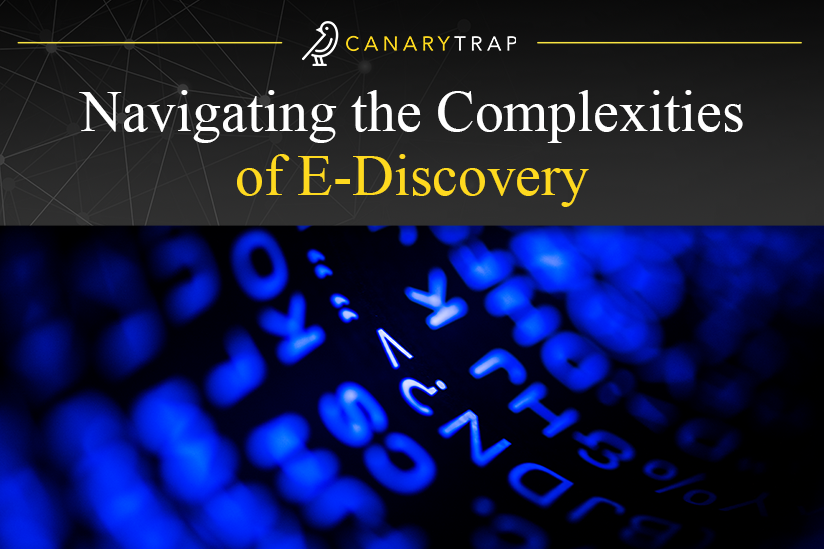Navigating the Complexities of E-Discovery
- August 28, 2023
- Canary Trap
In our increasingly digital world, the amount of electronically stored information (ESI) is growing at an unprecedented rate. With this surge in digital data, the need for efficient and effective methods to manage, preserve, and analyze electronic evidence has become paramount. This is where E-Discovery comes into play. In this blog post, we’ll delve into what E-Discovery is, why it’s important, the process it entails, its challenges, and best practices to ensure confidentiality throughout the E-Discovery journey.
What Is E-Discovery?
Electronic Discovery, often referred to as E-Discovery, is the process of identifying, collecting, preserving, and producing electronically stored information (ESI) as evidence in legal cases or investigations. ESI includes a wide range of digital data, such as emails, documents, databases, social media content, audio files, and more.
According to The Association for Intelligent Information Management (AIIM), “Examples of the types of ESI included are emails, instant messaging chats, documents, accounting databases, CAD/CAM files, Web sites, and any other electronic information that could be relevant evidence in a lawsuit. Also included in e-discovery are “raw data” and “metadata,” which forensic investigators can review for hidden evidence.”
With the use of E-Discovery applications, organizations will be able to pull information and records from a growing source of content spanning an entire organization and get past unnecessary data to reduce the efforts and costs of reviewing the content.
The Significance of E-Discovery in Cybersecurity
In an era where digital footprints are ever-present and cyber threats are rampant, the intersection of electronic discovery (E-Discovery) and cybersecurity has become paramount. E-Discovery is a critical component of modern litigation and regulatory compliance, as digital information has become a prevalent part of business operations and communication.
In an article published by Cloudficient it is mentioned that: “Since electronic systems may store an exorbitant amount of data, a diligent eDiscovery partner is essential to streamline the legal process and prevent future data disputes from occurring.”
However, although E-Discovery has been traditionally associated with legal proceedings, it has taken on a new role as a potent tool in uncovering and addressing cybersecurity incidents. Cybersecurity E-Discovery involves identifying, collecting, preserving, and analyzing electronic evidence related to security breaches, data breaches, and other cyber incidents. It serves as a crucial step in understanding the scope and impact of cyber threats while aiding organizations in taking appropriate remedial actions.
Let’s analyze the key significance of the E-Discovery process in cybersecurity:
- Identifying Breaches. E-Discovery helps organizations identify security breaches and unauthorized access to their digital systems. It involves analyzing logs, network traffic, and system activities to identify suspicious patterns and potential indicators of compromise.
- Forensic Analysis. E-Discovery techniques enable forensic analysts to reconstruct digital incidents, including the methods used by attackers, the timeline of events, and the extent of the breach.
- Evidence Preservation. Preserving digital evidence is crucial for both legal and cybersecurity purposes. E-Discovery ensures that electronic evidence is accurately collected and preserved to support incident investigations and potential legal actions.
- Data Breach Response. In the aftermath of a data breach, organizations must respond swiftly and effectively to mitigate damage. E-Discovery helps organizations assess the scope of the breach, identify compromised data, and determine the affected parties.
- Regulatory Compliance. Many industries are subject to regulations that require organizations to investigate and report security breaches promptly. E-Discovery assists in meeting regulatory requirements by providing accurate evidence of cyber incidents.
- Litigation Support. In cases where cyber incidents lead to legal disputes or litigation, E-Discovery plays a critical role in collecting electronic evidence to support legal actions or defense strategies.
How Does the E-Discovery Process Work?
E-Discovery is a multifaceted process that involves identifying, collecting, and reviewing electronic data relevant to a legal case. This process ensures that electronic evidence is legally obtained, accurately presented, and can withstand scrutiny in court.
The Complete Discovery Source team adds: “The processes and technologies around e-discovery are often complex because of the sheer volume of electronic data produced and stored. Additionally, unlike hardcopy evidence, electronic documents are more dynamic and often contain metadata such as time-date stamps, author and recipient information, and file properties. Preserving the original content and metadata for electronically stored information is required in order to eliminate claims of spoliation or tampering with evidence later in the litigation.”
The E-Discovery process involves several stages:
- Identification. This is the initial step where potentially relevant electronic information is identified. This can include locating relevant documents, files, emails, and other digital data sources.
- Preservation. Once potentially relevant ESI is identified, it needs to be preserved to prevent alteration, deletion, or loss. This involves creating forensic copies of the data, which is particularly important to maintain the integrity of the evidence.
- Collection. The collection phase involves gathering the identified ESI from various sources. This can be a complex process, as data may be dispersed across different devices, servers, and platforms. Collection can be targeted to specific custodians (individuals), time frames, or keywords to narrow down the volume of data collected.
- Processing. Collected ESI is processed to reduce its volume and extract relevant metadata. This makes it more manageable for review and analysis. Duplicate files and non-relevant data may be removed during this stage.
- Review. During this stage, legal professionals review the processed ESI to determine its relevance, privilege, and potential impact on the case. Reviewers often use specialized software to assist in this process.
- Analysis. The analyzed ESI helps legal teams understand the context and relevance of the collected information. This analysis can inform case strategy and decision-making.
- Production. If a certain ESI is deemed relevant and necessary for the case, it is produced to the opposing party or regulatory authorities. Production formats and protocols are often subject to legal agreements.
- Presentation. ESI that has been reviewed, analyzed, and produced can be presented as evidence in legal proceedings, such as court hearings or negotiations. Proper documentation and authentication of the ESI are crucial to establish its credibility in court.
- Admissibility and Expert Testimony. In some cases, experts in E-Discovery or digital forensics may provide testimony regarding the authenticity and integrity of the collected and produced ESI.
- Closure. Once the legal matter is resolved, data that was preserved for E-Discovery purposes may be deleted or retained according to an organization’s data retention policies.
Throughout the E-Discovery process, organizations and legal teams must ensure that everything is conducted in a defensible manner to meet legal and regulatory requirements. Collaboration between legal professionals, IT experts, digital forensics specialists, and other stakeholders is essential to successfully navigate the complexities of E-Discovery and ensure that relevant evidence is properly identified, preserved, and presented in legal proceedings.
Challenges of E-Discovery
While e-discovery opens new doors to efficiency and insight, it also presents a series of challenges that legal professionals must navigate skillfully. From the deluge of data to the intricacies of privacy, each challenge requires thoughtful consideration to ensure the integrity of the legal process.
- Volume and Complexity. The digital era has ushered in an unprecedented volume of electronic data, presenting both a challenge and an opportunity. The sheer amount of data demands careful curation, processing, and review. Additionally, the diverse range of data sources, from emails to databases and social media, adds complexity to the e-discovery process.
- Privacy Concerns. The convenience of e-discovery must be balanced against privacy considerations. Collecting sensitive personal or confidential data requires ethical and legal compliance. Striking the right balance between accessing necessary information and safeguarding individual privacy is a continuous challenge.
- Technical Expertise. E-discovery requires a unique blend of legal and technical expertise. Legal teams need to comprehend the intricacies of data formats, metadata, and search algorithms. Collaboration with IT professionals or experts well-versed in e-discovery tools is essential to navigate this complexity effectively.
- Legal and Regulatory Compliance. The legal landscape surrounding e-discovery is in constant flux. Laws and regulations vary across jurisdictions, making it imperative for legal teams to stay up-to-date. Ensuring compliance with data retention and disclosure requirements presents an ongoing challenge in the process.
- Data Preservation and Chain of Custody. Maintaining an unbroken chain of custody is pivotal in upholding the integrity of digital evidence. Yet, this challenge extends beyond physical documents; it involves preserving data across diverse devices and formats. Adhering to rigorous legal standards while doing so is a complex task.
As detailed by Alexander Gillies of TechTarget: “Two other issues with e-discovery include collection of new data types and reduction of cost. The cost of e-discovery is directly related to how much data needs to be collected and retained. As more and new types of data are collected, more money needs to be spent on storage, information technology and management. The review phase is also typically expensive, as individual documents need to be reviewed for relevance and privilege.”
Best Practices to Ensure Data Confidentiality During E-Discovery
As legal professionals traverse the intricate landscape of electronically stored information (ESI), ensuring data security and privacy becomes paramount. Let’s delve into best practices that empower legal teams to navigate E-Discovery while upholding the utmost confidentiality:
- Data Mapping and Classification. Conduct a comprehensive data mapping exercise to identify where sensitive information resides and categorize it based on its confidentiality level. This proactive approach enables targeted protection and minimizes data exposure.
- Safe Data Storage and Transmission. When dealing with electronic evidence, the security of data storage and transmission cannot be compromised. Utilize secure servers, encryption protocols, and virtual private networks (VPNs) to safeguard data at rest and in transit. Encryption ensures that even if data falls into the wrong hands, it remains unreadable and inaccessible.
- Control Access and Authentication. Implement strict access controls to restrict data access to authorized personnel only. Multi-factor authentication adds an additional layer of security by requiring multiple forms of verification for user access. This ensures that only approved individuals can interact with sensitive information.
- Non-Disclosure Agreements. Establish a culture of confidentiality by requiring all involved parties, including external vendors and experts, to sign non-disclosure agreements. These legally binding agreements outline the responsibilities and consequences of mishandling confidential data, adding an extra layer of accountability.
- Regular Security Audits and Updates. Conduct regular security audits to identify vulnerabilities in your e-discovery process. Stay up-to-date with the latest security patches and updates for all software and tools used. Proactive monitoring and maintenance ensure that your defenses remain resilient against evolving threats.
In the realm of modern litigation, the e-discovery process has transformed the way legal professionals gather, review, and present electronic information for legal cases. As we embrace the efficiencies of digitization, we must also prioritize the protection of sensitive and confidential information. By implementing these best practices, legal teams can uphold the highest standards of data protection throughout the e-discovery process and ensure its benefits are reaped without compromising their confidentiality.
In Conclusion
As we’ve explored the ins and outs of E-Discovery, it becomes evident that the balance between efficient data collection and the utmost protection of sensitive information is paramount. Legal professionals are entrusted with the responsibility of navigating intricate layers of data while upholding the integrity of the legal process. From the identification and preservation of electronically stored information to the collaborative efforts that involve IT experts, digital forensics specialists, and legal minds, every step is pivotal in the pursuit of justice.
The challenges are real, ranging from the overwhelming volume of data to the evolving legal landscape and privacy concerns. However, these challenges are not insurmountable. With a steadfast commitment to best practices—like comprehensive data mapping, secure data storage, controlled access, and adherence to non-disclosure agreements—we can navigate the complexities of E-Discovery while preserving confidentiality at every turn.
SOURCES:
- https://www.aiim.org/what-is-ediscovery
- https://cdslegal.com/knowledge/the-basics-what-is-e-discovery/
- https://www.techtarget.com/searchsecurity/definition/electronic-discovery-e-discovery-or-ediscovery
- https://www.cloudficient.com/blog/what-you-need-to-know-about-cybersecurity-and-ediscovery

